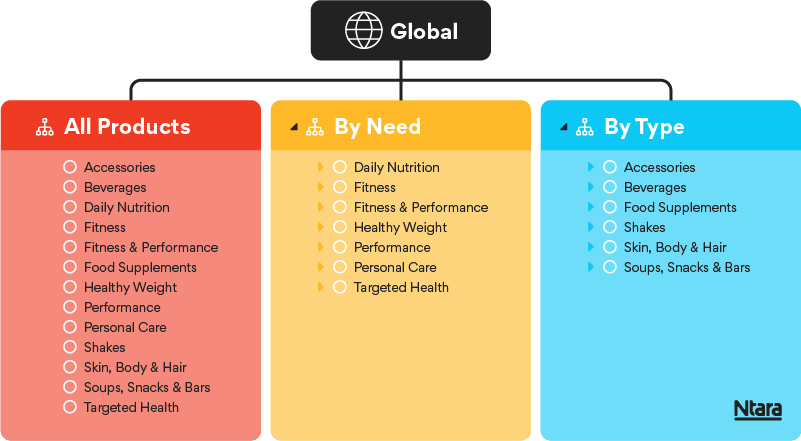In the world of PXM, the end goal is to build a trusted product experience. The work behind the scenes to get there? That’s where things can get complicated.
Taxonomy in PIM is one of those tricky areas. It’s the backbone of a consistent, accurate customer experience—the framework that organizes product information to meet internal standards and specific channel requirements.
Managing taxonomy, however, can be a huge undertaking. As channels and SKUs grow, so does the time and manual effort needed to keep everything in order.
But what if you could create a global taxonomy that maintains consistency but adapts effortlessly to the specific needs of every channel?
Ntara’s solution: Global master taxonomy
We developed a way to establish a unified global taxonomy for PIM, with the flexibility to adapt to each channel’s unique requirements.
Let’s look at an example, and then we’ll tell you how it works.

Nutritional brand juggles regulations
Take one of our clients, for example – a nutrition brand with a bestselling line of meal replacement shakes. Online shoppers can easily find these shakes under categories like “protein shakes” or “meal replacement.” Once they get to the product page, they see marketing copy, product attributes, images, videos, nutritional labels, flavor icons, and more. This information must be accurate, consistent, complete, and presented in the right context to support a buying decision.
However, channel and regulatory requirements can complicate matters. For instance, the term “meal replacement” is restricted in Canada, so the product must be marketed as “nutritional shakes.” This affects everything from product descriptions to images and infographics.
These nuances are handled through channel-specific taxonomies and, on a small scale, could be manageable. However, the brand deals with thousands of products across thousands of potential touchpoints, channels, and geographies. Keeping all of this straight can quickly become overwhelming.
How a global master taxonomy makes it simple
Global master taxonomy simplifies this process. Taxonomists can define a product’s core identity (e.g., a meal replacement shake remains a meal replacement shake) while giving marketers the flexibility to adapt the presentation of product data based on the channel’s context. The product stays consistent in the global taxonomy but can be modified to fit each channel’s unique needs. With the right code in place, these modifications by channel can be made automatically.
Things get even better when you connect PIM and DAM
For example, on the DAM side, your team can tag assets as “nutritional shake” to match the right taxonomies, such as those for regulated regions. Because the systems connect, product data and assets stay up-to-date and in the proper context for each channel. Your team can launch products faster and at scale while your customers enjoy a consistent, trusted experience
Who should consider global master taxonomy?
Global master taxonomy isn’t necessary for every business, but it’s a powerful solution for companies with omnichannel goals. It’s ideal for businesses that:
- Send product data to two or more channels.
- Benefit from automated rules that keep product information up to date with less manual effort.
- Want a standardized hierarchy for PIM and DAM, with the flexibility to adapt taxonomies for each channel’s context.
- Need an approach that’s faster, simpler for users, and cost-effective for the business.
Global master taxonomy is just one way we help businesses create buying trust across all channels today while staying ready for the challenges of the future—a hallmark of PXM.
Get in touch to learn how you can take advantage of this configuration.